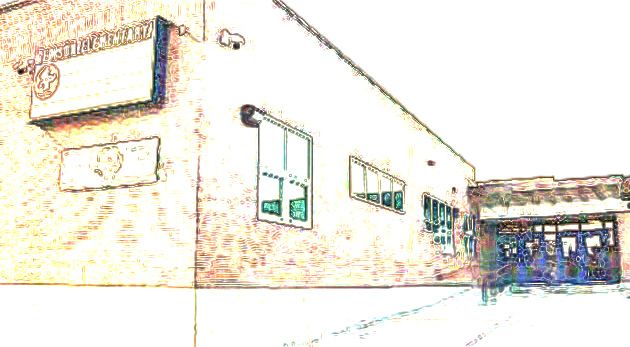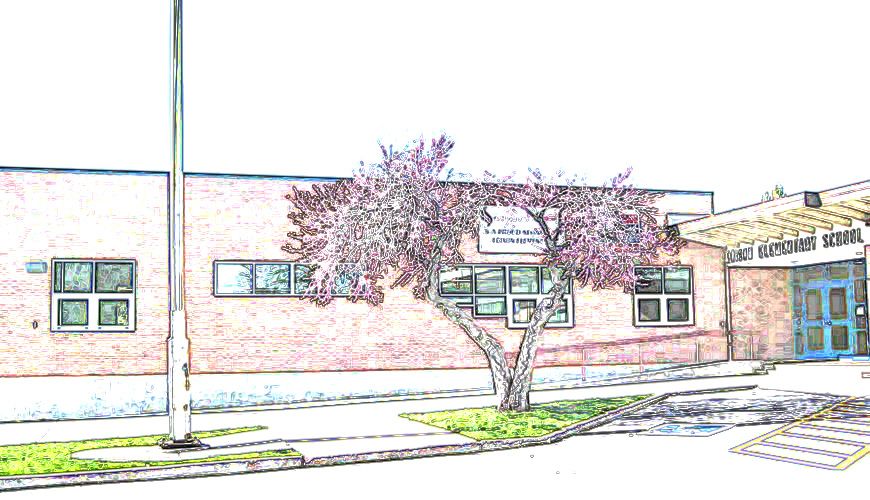With these observations about Edison Elementary, we continue our series on Salt Lake City public schools that have a high proportion of at-risk students.

Edison Elementary School
“I believe in kids, I trust kids…if you expect great things, you get great things.” –Dale Harding, Edison Elementary Principal
Edison School in Glendale first impressed me as a Place to Be with—it had a sense of great calm, and it was clean and orderly, without any of the confusion one often expects in an urban setting. Kids’ art covered the walls.
With 517 students in grades K-6, a preschool of 20, and a teaching staff of about 31 – all in a building built for 380 students – Edison is bursting its boundaries, both physically and in the many ways it exceeds the limitations and expectations much of the larger society tends to place upon low income, high mobility persons. Class size ranges from 24 in the lower grades to an outrageous 38 in the upper grades; nineteen classrooms of all kinds as well as two trailers house the classes. A gym, an auditorium and a gigantic playground accommodate sports, arts, cultural, social, and other enrichment activities. 3,000 donated books as well as other resources fill the new, light and airy library.
Volunteerism from the greater Salt Lake community runs extremely high: last year it totaled 14,000 hours! Neighbors of all kinds, senior citizens from all around the greater metro area, businesses (including the Bureau of Reclamation and The Salt Lake Tribune, which has an intense, ongoing involvement with the school), and University of Utah student nurses are only some of the volunteer categories.
 Edison is a mini-world where fifteen languages are spoken, with 72% of the students being other-than-white. They include Pacific Islanders, African-Americans, Hispanics of many kinds, various ethnic Asians. To be a minority is to be in the majority! Dr. Harding spoke of the poverty of moral values and the absence of hope that pervaded the school when he first arrived there. Most of the families – 40% with two parents in the home – struggle to survive in every dimension of their lives. But a sense of hope and optimism is beginning to take hold at Edison. Harding and the rest of the staff have been working energetically to make certain these kids will believe in themselves and in each other, that they will be open to a free and meaningful future.
Edison is a mini-world where fifteen languages are spoken, with 72% of the students being other-than-white. They include Pacific Islanders, African-Americans, Hispanics of many kinds, various ethnic Asians. To be a minority is to be in the majority! Dr. Harding spoke of the poverty of moral values and the absence of hope that pervaded the school when he first arrived there. Most of the families – 40% with two parents in the home – struggle to survive in every dimension of their lives. But a sense of hope and optimism is beginning to take hold at Edison. Harding and the rest of the staff have been working energetically to make certain these kids will believe in themselves and in each other, that they will be open to a free and meaningful future.“We have three rules: ‘Respect yourself; Respect other people; Respect property,’” explained Dr. Harding.
Dale Harding is in his fourth year [1995] as principal at Edison. He has had a long, wide-ranging and clearly impassioned career in education. Not only has he been teacher or administrator in Salt Lake City, coming to Edison after a term as principal at Uintah Elementary—he also has worked in Chile, Bolivia, Saudi Arabia and Wyoming. For six years he directed the experimental school at Utah State University. Surprisingly, Harding is the only Edison staff member fluent in Spanish. Four years ago there was no PTA, no community council at Edison; now both organizations are active. Very significantly, Harding has visited every home in the area. And observing the success he and the kids are having, he says, “‘I can’ is more important than IQ.”
In spite of the apparent heavy use of alcohol and other drugs in the families many of these kids hail from, very few Edison students are drug users themselves. “Just Say No” and D.A.R.E. Clubs help them resist the pressure to experiment. During 1993-94 there were thirteen gang members – now [1995] there’s only one.
Harding explained although many had learned to use “I’m a minority” as a copout, most no longer use it as an excuse, but take more responsibility for themselves and responsibility for others. There’s also a group of kids at Edison who live in stable settings where they experience a relatively normal, supportive environment without having to contend with overwhelming social pathology; many of those will be at the school from Kindergarten through 6th grade. Dr. Harding is optimistic that about 80% of Edison’s current population will graduate from high school.
The fine arts and the cultural arts are major aspects of life at Edison. I even heard the violin program of 5th and 6th graders in action! Ririe Woodbury Dance Company works with all of the students; the Salt Lake Tribune offers writers’ workshops; celebrations such as Black History Month and Cinco de Mayo help kids find meaning and excitement in their heritage. The arts and cultural assembly was one of the very first things Harding told me about! The assembly is a recurrent event that features the diversity of expression that has helped make Edison a miniature extension of the world beyond its borders.
 For fun, there’s reading books from the library, computer games in the 30-computer lab (when the academic stuff has been finished), a donated arcade that serves as a reward system, and of course the playground and sports, many of the sports facilitated by an after-school physical education teacher. Open until 9 pm three days of the week, until 6 pm on the other days, the Edison school building also houses and hosts various adult classes such as parenting, GED preparation and ESL.
For fun, there’s reading books from the library, computer games in the 30-computer lab (when the academic stuff has been finished), a donated arcade that serves as a reward system, and of course the playground and sports, many of the sports facilitated by an after-school physical education teacher. Open until 9 pm three days of the week, until 6 pm on the other days, the Edison school building also houses and hosts various adult classes such as parenting, GED preparation and ESL.As the very low absentee rate absolutely bears out, during the school day the students at Edison Elementary live a good life. Prior to arriving at Edison, many of these kids had been caught in multi-generational layers of ignorance and violence; they’d become what they had seen. With love, affirmation and support, the cycle of ignorance and abuse is breaking down, fear beginning to leave. At Edison, not only do they see an alternative—the environment actually enables them to be that alternative, to become different from what they had been. They’re becoming free, responsible and responsive persons.
They also are learning to live in a world in which diversity and difference is both normative and very good. For them, divergent styles mean learning to live with dissimilarities, and that leads to acceptance of differences. As Dr. Harding mentioned, he will not tolerate violence and aggression, and the question to resolve first always is “What happened?”—not “why?” As they learn from the staff and from each other how to live with diversity and to resolve conflict without fists or violence or any kind, hopefully the young peacemakers at Edison will grow up to become adult peacemakers.
At this point in time and space, Edison students are learning to live in a real community, with an authentic commonality. They’re in the process – just as all of us continue to be – of discovering the challenges and rewards of living together as friends, neighbors and citizens. But what of their futures? Their lives beyond Sixth Grade graduation day?
“So all of us, in union with Christ, form one body, and as parts of it we belong to each other.” –Romans 12:5
These words have become commonplace to many of us: we need to read in them, to feel in them, a live calling to reach out and to be inter-responsive to one another. Just as in great measure we have been created by each other, by one another, that creative process will continue to happen. The students at Edison will continue to need positive influences that will form and shape them into good citizens of their neighborhoods, of their cities, of their countries of this universe and of this galaxy—and even of unknown galaxies!
The students at Edison Elementary are ours, now and in the future. And we belong to them! Let's always remember that, and live our lives in response to it!

No comments:
Post a Comment
thanks for visiting—peace and hope to all of us!